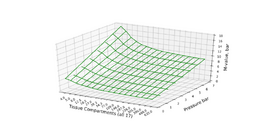A few months ago I met with a couple former tech students for a cave dive, and one of them told me with amusement of his dive the day before. He had randomly joined a group that included a technical instructor, and when that instructor learned that he used a GF Low of 50, he gave him a very worried "You're gonna die!" lecture about how important it is to do a first stop much, much deeper than that. That instructor can to a large extent be excused for not knowing anything about the way thinking has been changing over the last decade, because there really is no good, reliable resource for topics such as that. I wrote a blog about it a year again which I described going through a 10 page Google search in which I found 15-year old information repeated as if it were brand new and almost no articles whatsoever describing any of the thinking of the last decade.
That thinking has been quite robust, as was evidenced by a number of threads in different dive forums over the years, including on ScubaBoard.
I decided that I would try to help the situation out by writing a more accurate summary, and I enlisted the help of Dr. Simon Mitchell, who gave me a lot of good information and corrected my wording when it was necessary. Karl Shreeves of PADI was also quite helpful. It was just published yesterday, and I hope someone will find it helpful. Here it is.
Evolving Thought on Deep Decompression Stops
I am not a scientist. I do not do research. When the debates get hot and heavy, I let the people who know more than I carry the load while I watch carefully and try to learn. I am just a diver who would prefer to come back alive after every dive, but more than that, I want my present and former students to come back alive after every dive. I hope that making this information more readily available will help the technical diving community.
That thinking has been quite robust, as was evidenced by a number of threads in different dive forums over the years, including on ScubaBoard.
I decided that I would try to help the situation out by writing a more accurate summary, and I enlisted the help of Dr. Simon Mitchell, who gave me a lot of good information and corrected my wording when it was necessary. Karl Shreeves of PADI was also quite helpful. It was just published yesterday, and I hope someone will find it helpful. Here it is.
Evolving Thought on Deep Decompression Stops
I am not a scientist. I do not do research. When the debates get hot and heavy, I let the people who know more than I carry the load while I watch carefully and try to learn. I am just a diver who would prefer to come back alive after every dive, but more than that, I want my present and former students to come back alive after every dive. I hope that making this information more readily available will help the technical diving community.





